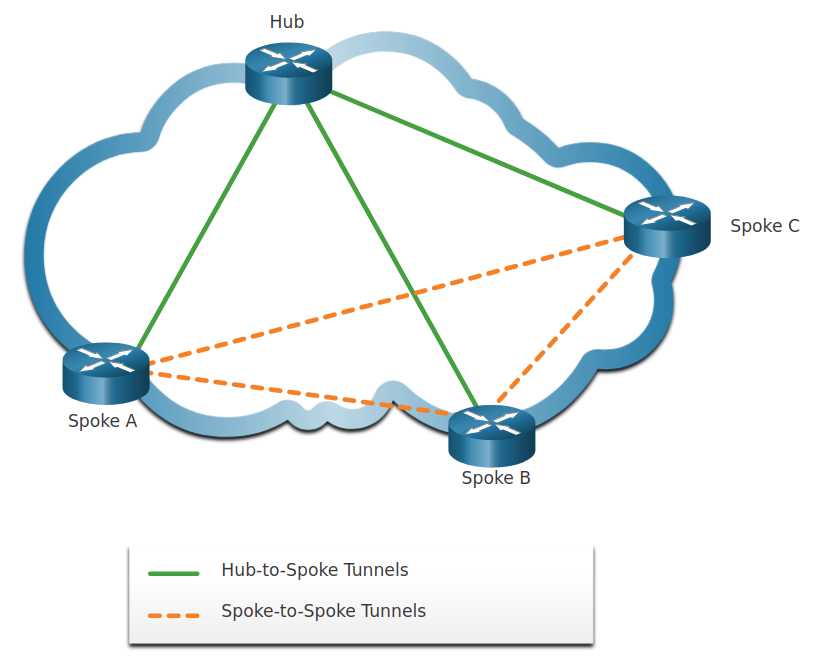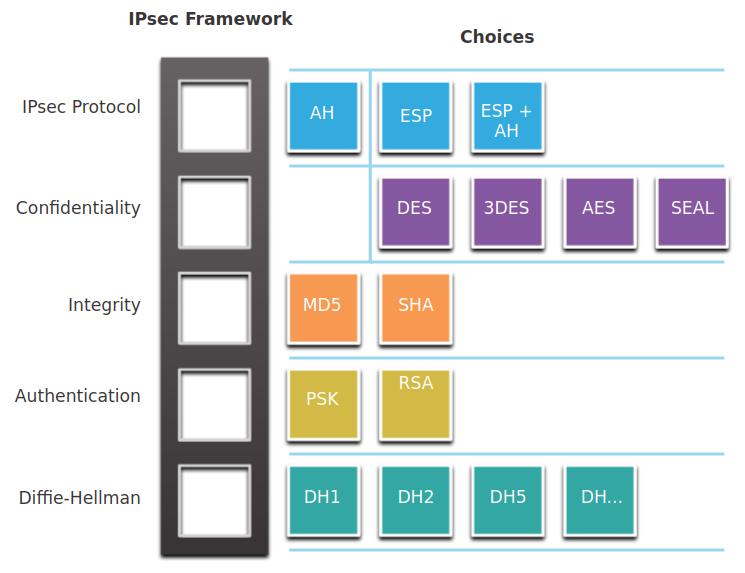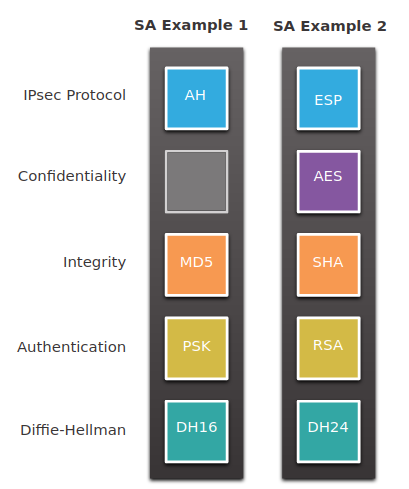VPN and IPsec
25 Nov 2020
Virtual Private Networks (VPN)
To secure network traffic between sites and users, organisations use virtual private networks (VPNs)
| Benefit | Description |
|---|---|
| Cost Savings | VPNs reduce an organisations connectivity costs while simultaneously increasing remote connection bandwidth. |
| Security | VPNs provide security by using advanced encryption and authentication protocols that protect data from unauthorised access. |
| Scalability | VPNs allow organisations to use the internet, making it easy to add new users without adding significant infrastructure. |
| Compatibility | VPNs can be implemented across a wide variety of WAN link options. Remote workers can gain secure access to their corporate networks. |
VPNs can be managed and deployed as:
Enterprise-Managed VPNs
Site-to-Site VPNs
- IPsec VPN
- GREover IPsec
- Cisco Dynamic Multipoint Virtual Private Network (DMVPN)
- IPsec Virtual Tunnel Interface (VTI)
Remote Access VPNs
- Client-based IPsec VPN connection
- Clientless SSL/TLS connection
Service Provider-Managed VPNs
Layer 2 MPLS
- Service provider is not involved in customer routing. A Virtual Private LAN Service (VPLS) is used to emulate an Ethernet multiaccess LAN segment
Layer 3 MPLS
- Service provider participates in customer routing, establishing a peering between routers.
Legacy Solutions
- Frame Relay
- Asynchronous Transfer Mode (ATM)
SSL/TLS vs IPsec
| Feature | IPsec | SSL |
|---|---|---|
| Applications supported | Extensive - All IP-based applications are supported. | Limited - Only web-based applications and file sharing are supported. |
| Authentication strength | Strong - Uses two-way authentication with shared keys or digital certificates. | Moderate - Using one-way or two-way authentication. |
| Encryption strength | Strong - Uses key lengths from 56 bits to 256 bits. | Moderate to strong - With key lengths from 40 bits to 256 bits. |
| Connection complexity | Medium - Because it requires a VPN client pre-installed on a host. | Low - It only requires a web browser on a host. |
| Connection option | Limited - Only specific devices with specific configurations can connect. | Extensive - Any device with a web browser can connect. |
GRE
Generic Routing Encapsulation (GRE) is a non-secure site-to-site VPN tunnelling (Carrier) protocol.
A standard IPsec VPN (non-GRE) can only create secure tunnels for unicast traffic. GRE supports multicast and broadcast traffic.
We can encapsulate routing protocol traffic using a GRE packet, and then encapsulate the GRE packet into an IPsec packet to forward it securely to the destination VPN gateway.
Dynamic Multipoint VPN (DMVPN)
Site-to-site IPsec VPNs and GRE over IPsec are adequate to use when there are only a few sites, they are not sufficient when the enterprise adds many more sites because each site would require static configurations to all other sites.
Dynamic Multipoint VPN (DMVPN) is a Cisco software solution for building multiple VPNs in an easy, dynamic, and scalable manner.
DMVPN relies on IPsec
It uses a hub-and-spoke configuration to establish a full mesh topology.
Each site is configured using Multipoint Generic Routing Encapsulation (mGRE). The mGRE tunnel interface allows a single GRE interface to dynamically support multiple IPsec tunnels.

IPsec Virtual Tunnel Interface (VTI)
Like DMVPNs, IPsec Virtual Tunnel Interface (VTI) simplifies the configuration process
IPsec VTI configurations are applied to a virtual interface instead of static mapping
VTI is capable of sending and receiving both IP unicast and multicast encrypted traffic.
IPsec Concepts
IPsec is an IETF standard that defines how a VPN can be secured across IP networks.
IPsec can protect traffic from Layer 4 through Layer 7 of the OSI model.
IPsec provides these essential security functions:
- Confidentiality - encryption algorithms to prevent reading the packet contents.
- Integrity - hashing algorithms to ensure that packets have not been altered. (MD5, SHA, HMAC)
- Origin authentication - Internet Key Exchange (IKE) protocol to authenticate source and destination pre-shared keys (passwords), digital certificates, or RSA certificates.
- Diffie-Hellman - Secure key exchange typically using various groups of the DH algorithm.

Terms
- AH - Authentication Header
- ESP - Encapsulating Security Payload
- SA - Security Associations
- IKE - Internet Key Exchange
A Security Association (SA) is the basic building block of IPsec.
the peers must share the same SA to negotiate key exchange parameters, establish a shared key, authenticate each other, and negotiate the encryption parameters.

AH does not offer confidentiality as all text is transported encrypted.
DH groups 1, 2, and 5 should no longer be used.